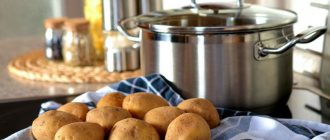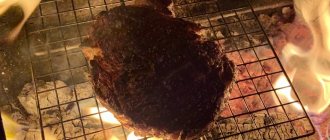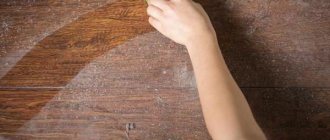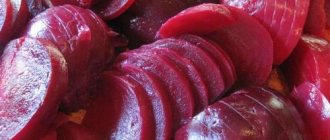This question, which worries many housewives, wanders from generation to generation. For my mother and me, it still remains unresolved. Do I need to skim off the foam when cooking meat? Many, including my mother, believe that it is necessary. She refers to the opinion of experts who declared scale to be the concentration of all substances harmful to the body. “When you cook broth, you should wait until it starts boiling and immediately skim off those gray flakes from its surface,” my mother constantly teaches, which is why real battles break out in our kitchen. Personally, I do not consider this issue to be fundamental, since I am familiar with a different point of view. What is the foam on the surface of borscht? Is it really so important to remove it and what is the best way to do it?
What is the foam that forms when cooking meat?
Meat is a protein product; in addition, it has a high content of fat and even bone particles. Protein tends to coagulate at high temperatures. During cooking, the main part of it remains in the meat, but what is on the surface and close to it is released into the water, where it turns into a light foam that floats to the top.
The foam that appears when cooking meat is coagulated protein.
Fresh, properly cut meat gives a light foam - white or slightly grayish. Dark gray or brown foam indicates that there is a lot of blood left in the meat. It is she who, curled up, gives such a dirty color. In addition, the meat may not be washed well. All the debris remaining on it will be pushed to the surface of the broth by the coagulated protein.
Poultry meat forms the least amount of foam, but only if it is store-bought. Homemade chicken, duck, and turkey are rarely dry and lean. The owners feed the birds well so that they not only lay eggs, but are also tasty later. For example, when I cook homemade chicken soup, I have to stand over the pan until the broth begins to boil with all its might, so as not to miss an ounce of foam. You don’t have to bother with store-bought chicken at all.
Store-bought chicken produces very little foam
In second place in terms of the amount of foam formed is beef, and pork takes first place. Still, there is a dependence on the ratio of proteins and fats: the fattier the meat, the more intensely the protein is released into the water. But from my own experience I can say: dark, brown foam appears more often on beef broth.
About hormones
Many are very afraid of hormones, which, as they put it, “inject” meat, so they drain this notorious first, and some second and third, broth.
However, it is important to understand that even if the use of hormones and other growth additives is used in the food industry, their concentration is strictly regulated and does not exceed the permissible limits!
In general, the hormones themselves in the feed have low bioavailability , i.e. poorly absorbed if obtained from food. That is why animals receive hormonal substances not with food, but by injection.
In the USA, according to standards, a cow after injection will have 24 mg. estradiol. If you eat a 500g steak, there will be a maximum of 0.18 micrograms of it. And our body will absorb 40-1000 times less than the amount of estradiol that is synthesized every day within ourselves.
In addition, most of the hormone obtained in this way is deactivated in the gastrointestinal tract and liver.
In general, antibiotics and hormones are indeed partially destroyed by heat treatment. Studies have shown that boiling destroys 20% of these substances. In chicken remains from 5.9% to 11.7%.
However, in order to get rid of everything unnecessary along with the first broth, you need to boil the chicken in the first water for at least 30 minutes, and the beef for 1 hour. In this case, 70% of the drugs go into the broth.
After this, the water is drained and the essentially boiled meat is cooked again, but for no more than 40 minutes. It turns out, of course, not soup, but water with boiled meat.
But we remind you that in Russia hormones are prohibited in animal husbandry , so is it worth even bothering with?
If you still think that our laying hens are stuffed with hormones, then you have simply never kept broilers at home. Believe me, they really gain a decent amount of weight in a short period of time without any special hormones, on one compound feed!
An interesting and extremely useful fact: the manufacturer has the right to produce food products according to its Technical Specifications (TS) or Organization Standards (STO).
This means that salt solutions can be injected into the meat to make it juicier, heavier and take less time to cook. Phosphates, starch, soy flour, milk proteins and other components that retain moisture are also used.
But in this case, if the chicken is specially soaked in a saline solution, it can no longer be called chicken or chicken, but is supplied as “semi-finished chicken for frying . But nothing else can be added to chicken produced in accordance with GOST.
So read the labels carefully.
Is it necessary to remove foam and why?
Curdled protein will not cause any harm to health. The only reason it is removed from the pan is because it looks unsightly. As soon as the water boils, the foam turns into unpleasant-looking flakes of varying sizes that are not so easy to catch. The broth becomes dark and cloudy. Therefore, the foam is removed immediately when it appears, before the water boils.
It is better to remove the dark, brown foam formed from the blood in the meat. Although it is no more harmful than regular blood, clotted blood has a specific taste that not everyone will like.
If the meat is fresh and clean, it is not necessary to remove the foam when cooking it.
It is imperative to remove foam contaminated with small particles of bone or debris from poorly washed meat. If you are in doubt about the origin of the meat (for example, it has been stored for a long time or, perhaps, has been chemically processed), it is better to do the following: wait until the broth boils, without removing the foam, and drain it. Pour fresh water over the meat and cook again.
The foam can be removed with a tablespoon or a slotted spoon. But it is most convenient to do this with a fine sieve for sifting flour. It perfectly passes clean broth and retains everything unnecessary.
These sieves for sifting flour will allow you to clear the broth from foam
If you still miss the moment and the foam curls into flakes, simply strain the broth through cheesecloth or a sieve. You can also pour a glass of cold water into the pan; this will cause the foam flakes to quickly rise to the surface, and you can easily collect them.
Why does foam form?
The foamy cap that covers the broth in the pan does not look very appetizing. But these are definitely not pollution or harmful substances. All meat and poultry contain a lot of protein. And foam is coagulated protein. During cooking, coagulation occurs, and as a result, foam forms on the surface of the water.
The slower the heating, the more proteins are released. Accordingly, a lot of foam appears. Increases its amount in blood. In this case, the foam cap also changes color - it turns brown.
The quality of the meat and its purity matter. Young veal produces less foam than beef.
How to reduce the amount of foam that forms when cooking broth
To prevent the appearance of foam in the broth from being critical, follow simple rules.
- Place raw meat not in cold, but in boiling water. When heated quickly, the protein will curl almost immediately inside the piece and will not have time to get out.
- During the cooking stage, shortly before the foam forms, add a peeled onion, whole or cut in half, into the broth. Protein flakes will stick to it. At the same time, the broth will become more flavorful.
Add an onion to cooking meat to reduce foaming
- A raw egg, beaten into the broth after the formation of protein foam, acts on the same principle as an onion.
- Pay attention to the quality of the meat. If it is young, there will be much less foam from it than from an old one. And, of course, wash meat thoroughly, even homemade meat.
Broth foam: should it be removed?
Remove or leave: is foam on broth harmful?- The lead singer of the Lyapis Trubetskoy group beat up a spectator right on stage
- “The registration was a success”: the Internet is discussing a sex video with a 15-year-old schoolgirl at a party
- Is it possible to eat old honey?
- Putin promised to review the “blurred criteria” of the law on foreign agents
- Aziza's friend named the killer Igor Talkov
- The first interview with the “Russian Vanga” from Chita. NTV exclusive
- A Muscovite found her stolen car and was left without a license
- To whom did actor Panin give $500 thousand before his death?
- Without cafes, cinema and karaoke: how life in Moscow will change on non-working days
- A lockdown will be introduced in Moscow from October 28
- EU leaders blame Moscow for European gas crisis
- Maxi, gloves and vaccination in the midst of an epidemic: a doctor answered popular questions about
- Porn actress opens up in hospital room after gang rape
What's going on with the kettle?
The rate of formation of a layer of solid deposits depends on the following factors:
- concentrations of chemical compounds in water;
- heating frequency;
- the quality of the surface of the walls, and in the electric kettle - the heating element. By the way, it is quite possible to remove it in an electric kettle at home, spending no more than half an hour.
When purchasing a new kettle, the process of scale accumulation will be slow, but will accelerate after using incorrect methods for cleaning kitchenware. These include mechanical impact with metal sponges and aggressive chemicals.
By damaging the surface, small defects are formed, into the cracks of which scale gets trapped and it becomes increasingly difficult to remove.
Why is scale in a kettle dangerous? Disadvantages of scale formation:
- Low coefficient of thermal conductivity and, as a result, more electricity (gas) is consumed to heat or maintain the desired temperature;
- Deformation. A deep layer of deposits, if you try to get rid of it, can damage the surface of the device.
When do legumes become anti-nutritional?
Beans and lentils contain phytic acid, which reduces the bioavailability of many minerals, such as calcium, zinc, magnesium and phosphorus. But this only happens to those who suddenly switch to legumes and start eating them in large quantities. It is clear that such a diet may make you feel worse.
Those who gradually got used to legumes, eat lentils, beans and peas regularly and in small portions, and also cook them correctly, on the contrary, note an improvement in their health. Scientists believe, for example, that vegetarians whose diet consists of legumes are better protected from osteoporosis than other meat-eaters.
Hence the second rule: introduce legumes into the diet gradually, in small portions.
As soon as the intestinal microflora gets used to breaking down phytic acid, all microelements will be fully absorbed.
By the way, it is also important to remember this rule because the starch in legumes can cause a spike in blood sugar in people who rarely eat beans, lentils or chickpeas. An unprepared body can react with a short-term increase in glucose levels, which is dangerous even for a healthy person. When switching to legumes, combine them with foods that have a low glycemic index (such as a green salad or fresh vegetables).











